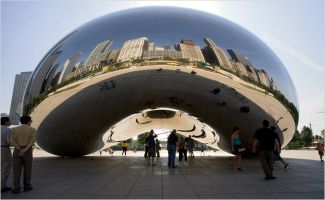 The Indian born artist Anish Kapoor has a major sculpture going up at Rockefeller Center in New York next month, and there's a detailed profile of him in the New York Times (thanks, Tamasha).
The Indian born artist Anish Kapoor has a major sculpture going up at Rockefeller Center in New York next month, and there's a detailed profile of him in the New York Times (thanks, Tamasha). The sculpture is called "Sky Mirror," and it's essentially a large, convex piece of highly polished stainless steel, roughly in the shape of a contact lens. From the image at the Times (which is computer generated) as well as images of the same sculpture at other sites, I have a feeling this piece is going to be a bit of a tourist sensation.
This high-profile placing of one of Kapoor's sculptures is a coup for the artist, but hardly the first time he's been given pride of place in the western art world. Major pieces of his are on display in the MOMA and the Tate Modern in London, the most famous of which might be Marsyas, a massive construction that filled the Tate's vast Turbine Hall four years ago. Kapoor is one of the most important and influential practitioners of a movement in abstract sculpture called either minimalism or post-minimalism, depending on how exact we're being.
It's a long way to come for a Doon School boy.
Let's get into the art a bit more. Here is the Times:
Both works are extensions of Mr. Kapoor’s almost career-long interest in sculptural incorporeality. Borrowing ideas from Minimalist and post-Minimalist predecessors like Donald Judd, Bruce Nauman and Eva Hesse but using deep matte colors, reflectiveness and other illusions, he makes boundaries seem to disappear with an effect that is often overtly sensual and spiritual. Mr. Kapoor, who first rose to prominence in the mid-1980’s and won the Turner Prize in Britain in 1991, calls them nonobjects. (link)
 Minimalism came of age in the 1960s, and was displaced somewhat by postmodernism and conceptual art, though it never really went away. For the most part I tend to prefer more congenial, conversational art, but a number of Kapoor's pieces do something for me that Donald Judd's roomfuls of black cubes don't really do. Kapoor's best works clearly are social objects, even if they operate in the same general mode as minimalism does.
Minimalism came of age in the 1960s, and was displaced somewhat by postmodernism and conceptual art, though it never really went away. For the most part I tend to prefer more congenial, conversational art, but a number of Kapoor's pieces do something for me that Donald Judd's roomfuls of black cubes don't really do. Kapoor's best works clearly are social objects, even if they operate in the same general mode as minimalism does.A bit more from the same article:
Though his public work is unabashedly crowd-pleasing, Mr. Kapoor’s intentions are often deeply philosophical. His mirrored piece might be thought of as a sculptural twist on the ideas of the German philosopher Johann Fichte, who wrote about self-consciousness being possible only through the resistance an individual encounters from external objects; in other words, something defined by what it is not. (link)
 What I like about the "Sky Mirror" piece and a related piece now installed at Millenium Park in Chicago called "Cloud Gate" is the way they present a kind of prism through which to view the world. They are solid, stainless steel, and point at the monumental architecture around themselves -- and in that sense they are completely of a piece with the modern American city. But in that they have the general look of liquids, they resist the sense of fixity of massive public sculptures, which are sometimes more in the vein of decorative buildings than art objects that inspire contemplation. As the Times notes, in the convex mirror of "Sky Mirror," the towering buildings facing the sculpture are vertically inverted -- another kind of anomaly.
What I like about the "Sky Mirror" piece and a related piece now installed at Millenium Park in Chicago called "Cloud Gate" is the way they present a kind of prism through which to view the world. They are solid, stainless steel, and point at the monumental architecture around themselves -- and in that sense they are completely of a piece with the modern American city. But in that they have the general look of liquids, they resist the sense of fixity of massive public sculptures, which are sometimes more in the vein of decorative buildings than art objects that inspire contemplation. As the Times notes, in the convex mirror of "Sky Mirror," the towering buildings facing the sculpture are vertically inverted -- another kind of anomaly. Incidentally, many of Kapoor's early works made oblique references to Indian religious rituals -- some of his minimalist forms from the 1980s, for instance, were coated in bright red powder in the manner of Hindu religious shrines (see this piece, for instance). The tie back to India seems to be less evident in Kapoor's recent 'big' works, though many art critics draw on Buddhist concepts of space and being (or non-being) in attempting to analyze Kapoor's work. So it might still be there.